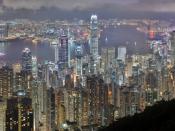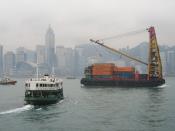1. Introduction
Hong Kong is fortunate in having a sheltered natural harbour, which provides good access and a safe haven for vessels calling at the port from around the world. The port has always been a key factor in the development and prosperity of Hong Kong, which is strategically located on the Far East trade routes and is in the geographical centre of the now fast-developing Asia- Pacific Basin. Shipping and maritime activities beat at the heart of Hong Kong, accounting for more than 20 percent of Hong Kong's gross domestic product (GDP).
In 2003, Hong Kong handled over 20 million TEUs, making it the busiest container port in the world for over ten consecutive years. In terms of tonnage of shipping using its facilities, cargo handled and the number of passengers carried, Hong Kong is one of the major ports of the world.
Port facilities giving a helping hand in the above amazing result include about 6,000 meters of quays at Kwai Chung and Stonecutters container terminals; about 7,740 meters of quays at public cargo working areas (PCWAs); and 53 mooring buoys for ocean-going vessels.
Port users have a choice of using 4 different types of port facilities to handle their container: container terminal, mid-stream operator, River Trade Terminal and PCWAs (Cheng and Wong, 1997)
This report will focus on mid-stream operations in Hong Kong by introducing their present status, analyzing the operational efficiency and cost as compared with container terminals, safety aspect and summarizing the outlook of the industry.
2. Definition
According to Hong Kong Port Development Council (http://www.pdc.gov.hk), mid-stream operations involve the loading and unloading of cargo ships mooring at buoys or anchorages in the harbor. A wide range of vessels from bulk, break-bulk, semi-container to fully cellular container ships are served. Currently, the mid-stream...


